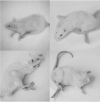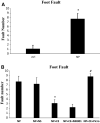Improvement of pyridoxine-induced peripheral neuropathy by Cichorium intybus hydroalcoholic extract through GABAergic system
- PMID: 30712095
- PMCID: PMC10718042
- DOI: 10.1007/s12576-019-00659-8
Improvement of pyridoxine-induced peripheral neuropathy by Cichorium intybus hydroalcoholic extract through GABAergic system
Abstract
Pyridoxine (vitamin B6) toxicity is a well-known model for peripheral neuropathy. GABA and glutamate are two neurotransmitters in neural pathways involved in the peripheral neuropathy. Cichorium intybus (Chicory) contains glycosides and triterpenoids, which inhibit glutamatergic transmission and enhance GABAergic transmission. The present study was aimed at studying the effect of chicory extract (CE) on the pyridoxine-induced peripheral neuropathy with a particular focus on glutamatergic and GABAergic systems. In this experimental study, a high dose of pyridoxine (800 mg/kg, i.p.) was injected for 14 days to induce neuropathy in male rats. To evaluate the behavioral symptoms, three tests including rotarod, hot plate, and foot fault were used. After the induction of neuropathy, CE (50 mg/kg i.p.) was injected intraperitoneally for 10 consecutive days. Morphologically, the sciatic nerve and the DRG neurons were evaluated in the control, neuropathy, and chicory groups by H&E staining. For evaluating the mechanism, picrotoxin (1 mg/kg) and MK-801 (0.1 mg/kg) were also individually injected 15 min before the extract administration. The concentration of TNF-α in rat sciatic nerve and DRG neurons were also measured by enzyme-linked-immunoassay (ELISA). Morphological and physiological changes occurred in the DRG and sciatic nerve following pyridoxine intoxication. The CE exerted an anti-neuropathic effect on the sciatic nerve and DRG neurons and also decreased reaction time in hot plate test (p < 0.05), increased balance time in rotarod test (p < 0.001), and improved foot fault performance (p < 0.01). Moreover, CE administration reduced TNF-α level in DRG (p < 0.001) and sciatica nerve (p < 0.001). Picrotoxin, unlike MK-801, showed a significant difference in all three behavioral tests and reduced TNF-α content in comparison with group received extraction alone (with p < 0.001 for all three tests). Our results showed beneficial effects of CE on pyridoxine-induced peripheral neuropathy. Modulating of the GABAergic system mediated by TNF-α may be involved in the anti-neurotoxic effect of CE.
Keywords: CE; DRG; GABA; Glutamate; Peripheral neuropathy; Pyridoxine; Sciatic nerve.
Conflict of interest statement
All named authors hereby declare that they have no conflicts of interest to disclose.
Figures










References
-
- Azhary H, et al. Peripheral neuropathy: differential diagnosis and management. Am Fam Physician. 2010;81(7):887–892. - PubMed
MeSH terms
Substances
LinkOut - more resources
Full Text Sources
Medical

